Modification Mechanism and Rheological Properties of Emulsified Asphalt Evaporative Residues Reinforced by Coupling-Modified Fiber
Abstract
:1. Introduction
2. Raw Materials
2.1. Emulsified Bitumen
2.2. Basalt Fiber
2.3. Silane Coupling Agents
3. Experimental Details and Methods
3.1. Preparation of Silane Coupling Agent Modified Basalt Fiber (MBF)
3.2. Preparation of Emulsified Asphalt Evaporation Residue
3.3. Test Details
3.4. Test Methods
4. Experimental Results and Discussions
4.1. Performance Analysis of Silane Coupling Agent-Modified Basalt Fiber (MBF)
4.1.1. Breaking Strength and Breaking Elongation
4.1.2. Microscopic Analysis of Silane Coupling Agent Modified Basalt Fibers (MBF)
4.2. Performance Analyses of Emulsified Asphalt Evaporative Residues Reinforced by MBF
4.2.1. Effect of MBF Content on the Performance of Emulsified Asphalt Evaporation Residue
- I.
- Conventional Performance Test
- II.
- Dynamic Shear Rheology Test
- III.
- Low-Temperature Performance
4.2.2. Mechanism Analysis of MBF Emulsified Asphalt Evaporation Residue
- I.
- Principle of SBR-Enhanced Ductility of Emulsified Asphalt
- II.
- The Effect of MBF on Functional Groups of Emulsified Asphalt
- III.
- Microstructure Analysis of MBF-Emulsified Asphalt
5. Conclusions
Author Contributions
Funding
Institutional Review Board Statement
Informed Consent Statement
Data Availability Statement
Conflicts of Interest
References
- Liu, L.; Han, Z.; Wu, P.; Zheng, G.; Sun, L. Study on the Laboratory Mixing and Compaction Methodology of Emulsified Asphalt Cold Recycled Mixture. Front. Mater. 2020, 7, 231. [Google Scholar] [CrossRef]
- Pi, Y.; Li, Y.; Pi, Y.; Huang, Z.; Li, Z. Strength and Micro-Mechanism Analysis of Cement-Emulsified Asphalt Cold Recycled Mixture. Materials 2020, 13, 128. [Google Scholar] [CrossRef] [PubMed] [Green Version]
- Dondi, G.; Tataranni, P.; Pettinari, M.; Sangiorgi, C.; Simone, A.; Vignali, V. Crumb Rubber in cold recycled bituminous mixes: Comparison between Traditional Crumb Rubber and Cryogenic Crumb Rubber. Constr. Build. Mater. 2014, 68, 370–375. [Google Scholar] [CrossRef]
- Sangiorgi, C.; Tataranni, P.; Simone, A.; Vignali, V.; Lantieri, C.; Dondi, G. A laboratory and filed evaluation of Cold Recycled Mixture for base layer entirely made with Reclaimed Asphalt Pavement. Constr. Build. Mater. 2017, 138, 232–239. [Google Scholar] [CrossRef]
- Lyu, Z.; Shen, A.; Qin, X.; Yang, X.; Li, Y. Grey target optimization and the mechanism of cold recycled asphalt mixture with comprehensive performance. Constr. Build. Mater. 2019, 198, 269–277. [Google Scholar] [CrossRef]
- Filho, W.U.; Gutiérrez Klinsky, L.M.; Motta, R.; Bariani Bernucci, L.L. Cold Recycled Asphalt Mixture using 100% RAP with Emulsified Asphalt-Recycling Agent as a New Pavement Base Course. Adv. Mater. Sci. Eng. 2020, 2020, 5863458. [Google Scholar] [CrossRef] [Green Version]
- Si, J.; Wang, Z.; Li, J.; Zuo, C.; Zhang, P.; Wei, C.; Wang, J.; Li, W.; Miao, S. Effects of CaO added to raw basalt on producing continuous basalt fibers and their mechanical properties. J. Non-Cryst. Solids 2021, 568, 120941. [Google Scholar] [CrossRef]
- Zhang, W.; Zhang, Y.; Liu, B. Hybrid effect of basalt fiber and carbon fiber on the mechanical properties and microstructure of oil well cement. Constr. Build. Mater. 2021, 286, 122696. [Google Scholar] [CrossRef]
- Sanjay, M.R.; Madhu, P.; Jawaid, M.; Senthamaraikannan, P.; Senthil, S.; Pradeep, S. Characterization and properties of natural fiber polymer composites: A comprehensive review. J. Clean. Prod. 2018, 172, 566–581. [Google Scholar] [CrossRef]
- Lou, K.; Kang, A.; Xiao, P.; Wu, Z.; Li, B.; Wang, X. Effects of basalt fiber coated with different sizing agents on performance and microstructures of asphalt mixture. Constr. Build. Mater. 2021, 266, 121155. [Google Scholar] [CrossRef]
- Kim, J.J.; Kim, D.J.; Kang, S.T.; Lee, J.H. Influence of sand to coarse aggregate ratio on the interfacial bond strength of steel fibers in concrete for nuclear power plant. Nucl. Eng. Des. 2012, 252, 1–10. [Google Scholar] [CrossRef]
- Luo, Y.; Zhang, K.; Xie, X.; Yao, X. Performance evaluation and material optimization of Micro-surfacing based on cracking and rutting resistance. Constr. Build. Mater. 2019, 206, 193–200. [Google Scholar] [CrossRef]
- Ge, Z.; Wang, H.; Zhang, Q.; Xiong, C. Glass fiber reinforced asphalt membrane for interlayer bonding between asphalt overlay and concrete pavement. Constr. Build. Mater. 2015, 101, 918–925. [Google Scholar] [CrossRef]
- Gu, X.; Zhang, X.; Lv, J.; Huang, Z.; Yu, B.; Zou, X. Laboratory Performance Evaluation of Reinforced Basalt Fiber in Sealing Asphalt Chips. J. Test. Eval. 2017, 46, 20160186. [Google Scholar] [CrossRef]
- Chen, H.; Xu, Q. Experimental study of fibers in stabilizing and reinforcing asphalt binder. Fuel 2010, 89, 1616–1622. [Google Scholar] [CrossRef]
- Iorio, M.; Marra, F.; Santarelli, M.; González-Benito, J. Reinforcement-matrix interactions and their consequences on the mechanical behavior of basalt fibers-cement composites. Constr. Build. Mater. 2021, 309, 125103. [Google Scholar] [CrossRef]
- Li, L.; Xia, Z. Role of interfaces in mechanical properties of ceramic matrix composites. In Advances in Ceramic Matrix Composites; Elsevier: Amsterdam, The Netherlands, 2018; pp. 355–374. [Google Scholar]
- Abbas, Y.M.; Khan, M.I. Fiber–Matrix Interactions in Fiber-Reinforced Concrete: A Review. Arab. J. Sci. Eng. 2016, 41, 1183–1198. [Google Scholar] [CrossRef]
- Lilli, M.; Jurko, M.; Sirjovova, V.; Zvonek, M.; Cech, V.; Scheffler, C.; Rogero, C.; Ilyn, M.; Tirillo, J.; Sarasini, F. Basalt fibre surface modification via plasma polymerization of tetravinylsilane/oxygen mixtures for improved interfacial adhesion with unsaturated polyester matrix. Mater. Chem. Phys. 2021, 274, 125106. [Google Scholar] [CrossRef]
- Li, J.; Shen, S. Effects of acid modification on coupling agent amount of basalt fiber surface and mechanical property of BF/epoxy composites. Acta Mater. Compos. Sin. 2014, 31, 888–894. [Google Scholar]
- Liu, T.; Bai, R.; Chen, Z.; Li, Y.; Yang, Y. Tailoring of polyethylene fiber surface by coating silane coupling agent for strain hardening cementitious composite. Constr. Build. Mater. 2021, 278, 122263. [Google Scholar] [CrossRef]
- Lin, G.; Wang, H.; Yu, B.; Qu, G.; Chen, S.; Kuang, T.; Yu, K.; Liang, Z. Combined treatments of fiber surface etching/silane-coupling for enhanced mechanical strength of aramid fiber-reinforced rubber blends. Mater. Chem. Phys. 2020, 255, 123486. [Google Scholar] [CrossRef]
- Iorio, M.; Santarelli, M.; González-Gaitano, G.; Gonzalez-Benito, J. Surface modification and characterization of basalt fibers as potential reinforcement of concretes. Appl. Surf. Sci. 2018, 427, 1248–1256. [Google Scholar] [CrossRef]
- Deak, T. Enhancement of interfacial properties of basalt fiber reinforced nylon 6 matrix composites with silane coupling agents. Express Polym. Lett. 2010, 4, 590–598. [Google Scholar] [CrossRef]
- Maria, L.S.; Francesca, S.; Martina, Z.; Jacopo, T.; Fabrizio, S. Basalt fiber reinforced natural hydraulic lime mortars: A potential bio-based material for restoration. Mater. Des. 2014, 63, 398–406. [Google Scholar]
- Song, Q.X.; Liu, H.W.; Xu, P.; Zhong, Z.L.; Shi, L.; Zhao, D.F.; Donghua, U. Effect of Coupling Agent Treatment of Basalt Fiber on Mechanical Properties of BF Reinforced PP Thermoplastic Panel; China Textile Publication: Shanghai, China, 2009; pp. 403–406. [Google Scholar]
- Cagrialp, A.; Mehmet, D. The effects of silane coupling agents on the mechanical properties of basalt fiber reinforced poly(butylene terephthalate) composites. Compos. Part B 2018, 146, 145–154. [Google Scholar]
- Lee, S.O.; Rhee, K.Y.; Park, S.J. Influence of chemical surface treatment of basalt fibers on interlaminar shear strength and fracture toughness of epoxy-based composites. J. Ind. Eng. Chem. 2015, 32, 153–156. [Google Scholar] [CrossRef]
- Haido, J.H. Flexural behavior of basalt fiber reinforced concrete beams: Finite element simulation with new constitutive relationships. Structrues 2020, 27, 1876–1889. [Google Scholar] [CrossRef]
- Haido, J.H.; Tayeh, B.A.; Majeed, S.S.; Karpuzcu, M. Effect of high temperature on the mechanical properties of basalt fibre self-compacting concrete as an overlay material. Constr. Build. Mater. 2021, 268, 121725. [Google Scholar] [CrossRef]
- Gao, C.; Wu, W. Using ESEM to analyze the microscopic property of basalt fiber reinforced asphalt concrete. Int. J. Pavement Res. Technol. 2018, 11, 374–380. [Google Scholar] [CrossRef]
- Liu, Y.; Tan, L.; Xuan, W.; Xu, H. Study of Interface Effect of Modified Fiber Reinforced Emulsified Asphalt Based on the Micro-Analyses. Transp. Res. Congr. 2019, 155–163. [Google Scholar] [CrossRef]
- Zhu, S.; Xu, Z.; Qin, X.; Liao, M. Fiber-Reinforcing Effect in the Mechanical and Road Performance of Cement-Emulsified Asphalt Mixtures. Materials 2021, 14, 2779. [Google Scholar] [CrossRef] [PubMed]
- Wang, L.; Wang, M.; Wang, P.; Lu, J. Mechanical properties of coupling agent modified basalt fiber reinforced cement-based composites. Mater. Rep. 2019, 33, 273–277. (In Chinese) [Google Scholar]
- Ghouti, H.A.; Zegaoui, A.; Derradji, M.; Zu, L.-W.; Cai, W.-A.; Wang, J.; Dayo, A.Q.; Liu, W.-B. Structural and mechanical characteristics of silane-modified PIPD/basalt hybrid fiber-reinforced polybenzoxazine composites. Mater. Chem. Phys. 2019, 237, 121850. [Google Scholar] [CrossRef]
- Liu, Y.; Zhang, Z.; Tan, L.; Xu, Y.; Wang, C.; Liu, P.; Yu, H.; Oeser, M. Laboratory evaluation of emulsified asphalt reinforced with glass fiber treated with different methods. J. Clean. Prod. 2020, 274, 123116. [Google Scholar] [CrossRef]
- Sun, X.; Gao, Z.; Cao, P.; Zhou, C.; Ling, Y.; Wang, X.; Zhao, Y.; Diao, M. Fracture performance and numerical simulation of basalt fiber concrete using three-point bending test on notched beam. Constr. Build. Mater. 2019, 225, 788–800. [Google Scholar] [CrossRef]
- Xiang, Y.; Xie, Y.; Long, G. Effect of basalt fiber surface silane coupling agent coating on fiber-reinforced asphalt: From macro-mechanical performance to micro-interfacial mechanism. Constr. Build. Mater. 2018, 179, 107–116. [Google Scholar] [CrossRef]
- Shah, S.F.A.; Chen, B.; Oderji, S.Y.; Haque, M.A.; Ahmad, M.R. Comparative study on the effect of fiber type and content on the performance of one-part alkali-activated mortar. Constr. Build. Mater. 2020, 243, 118221. [Google Scholar] [CrossRef]
- Noushini, A.; Hastings, M.; Castel, A.; Aslani, F. Mechanical and flexural performance of synthetic fibre reinforced geopolymer concrete. Constr. Build. Mater. 2018, 186, 454–475. [Google Scholar] [CrossRef]
- Manylov, M.S.; Gutnikov, S.I.; Pokholok, K.V.; Lazoryak, B.I.; Lipatov, Y.V. Crystallization mechanism of basalt glass fibers in air. Mendeleev Commun. 2013, 23, 361–363. [Google Scholar] [CrossRef]

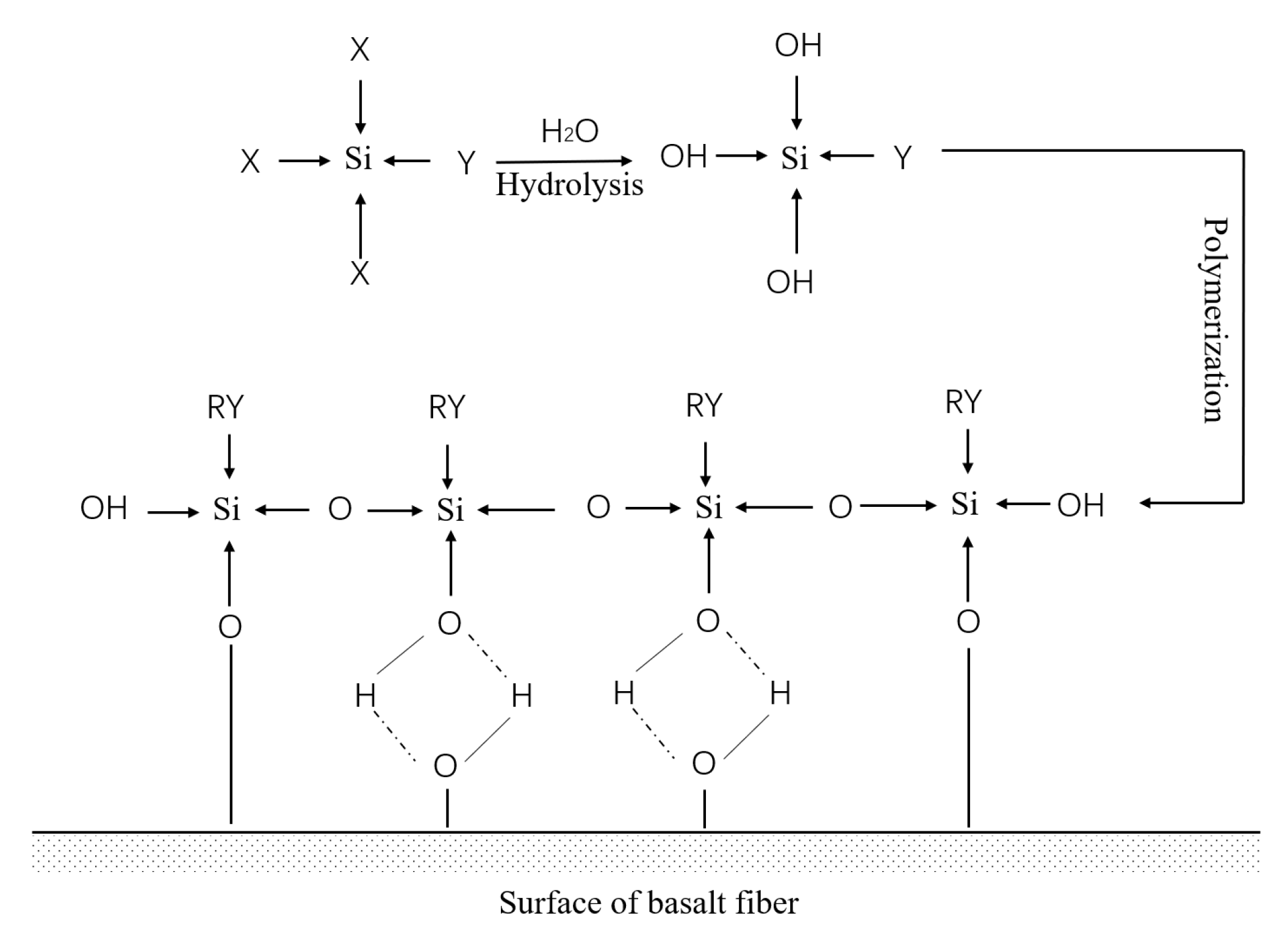

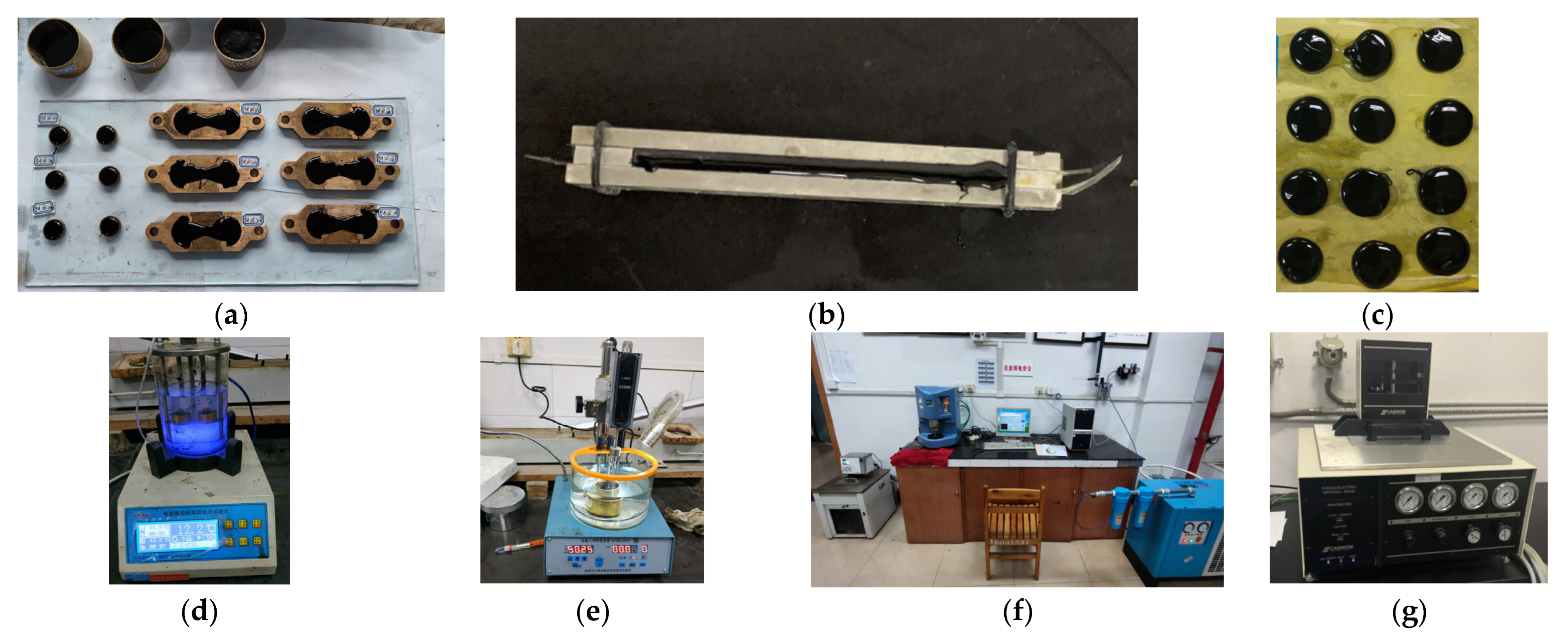
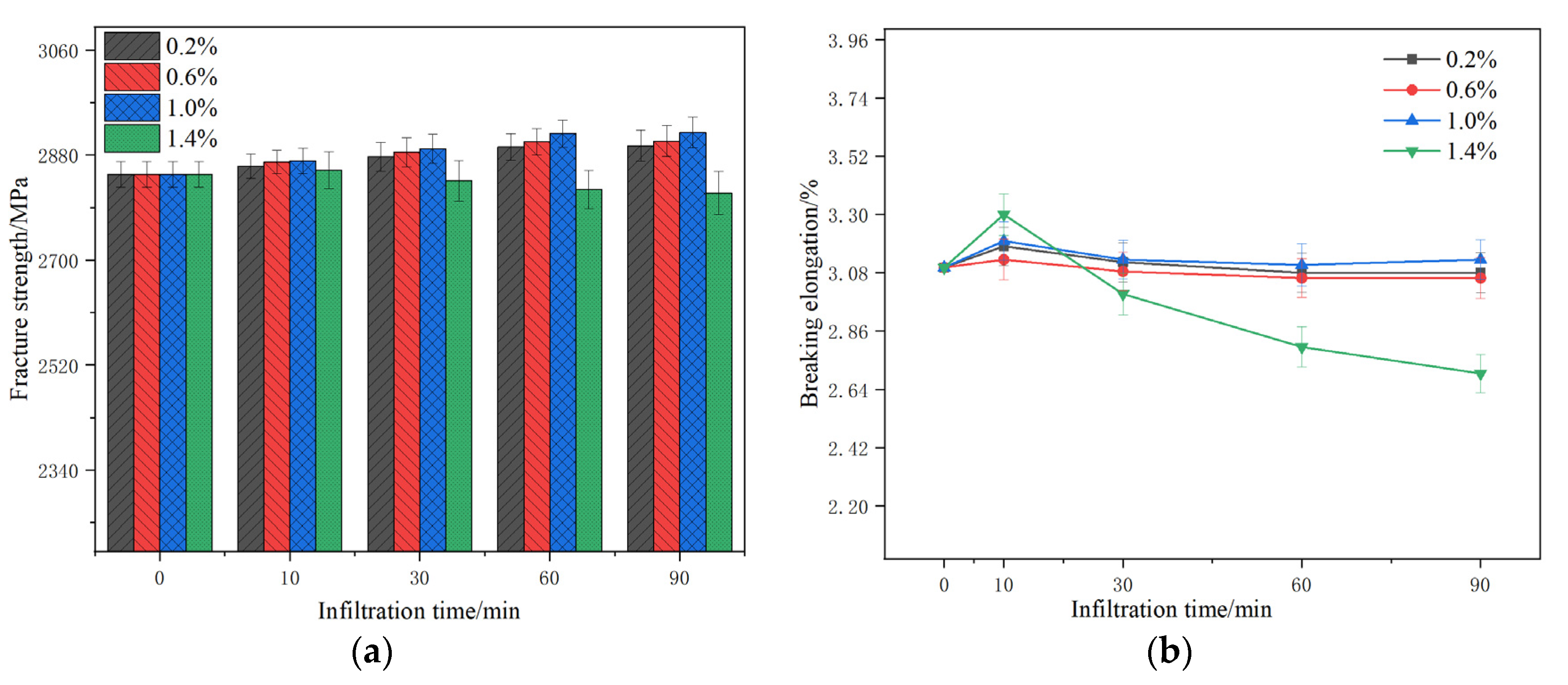

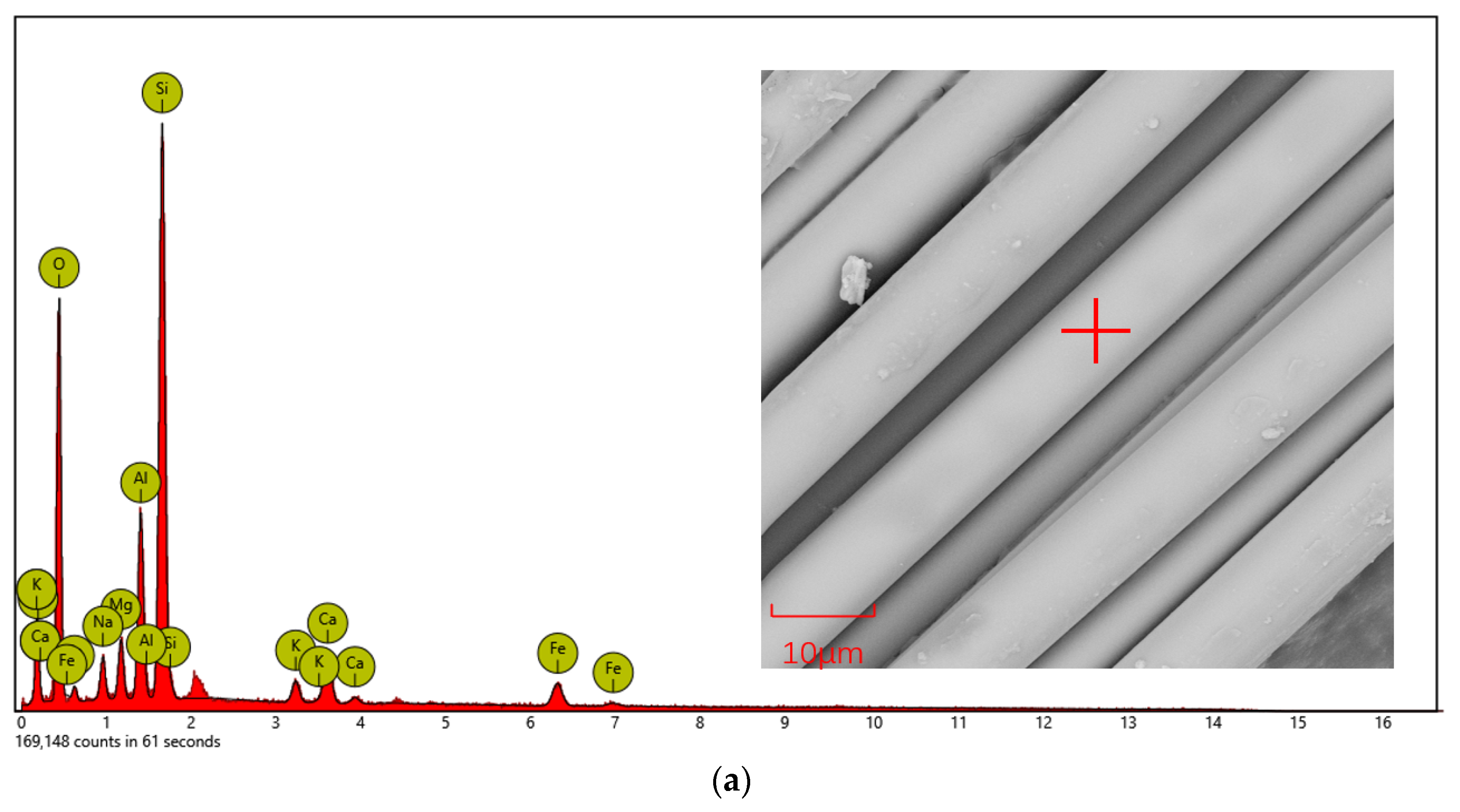

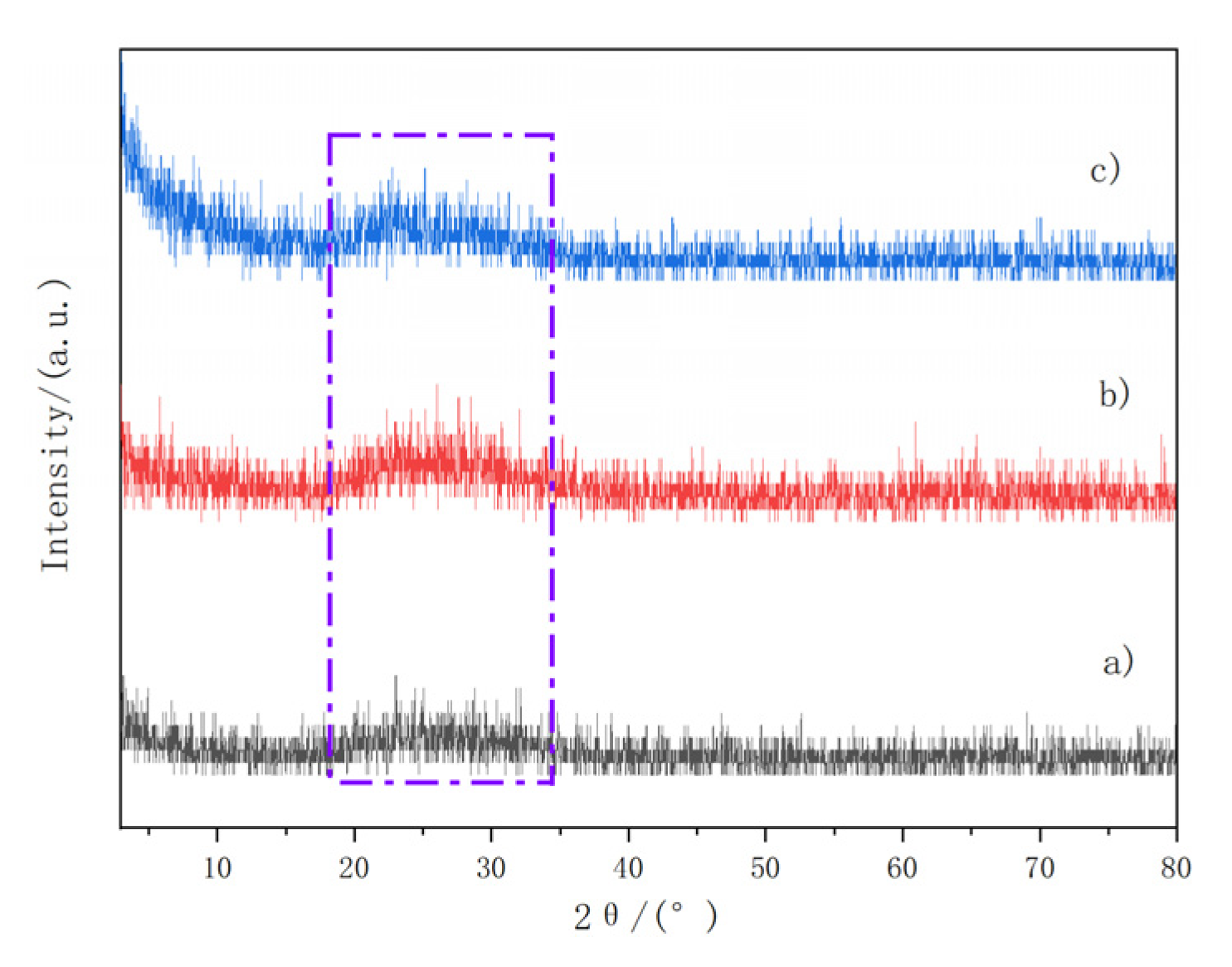
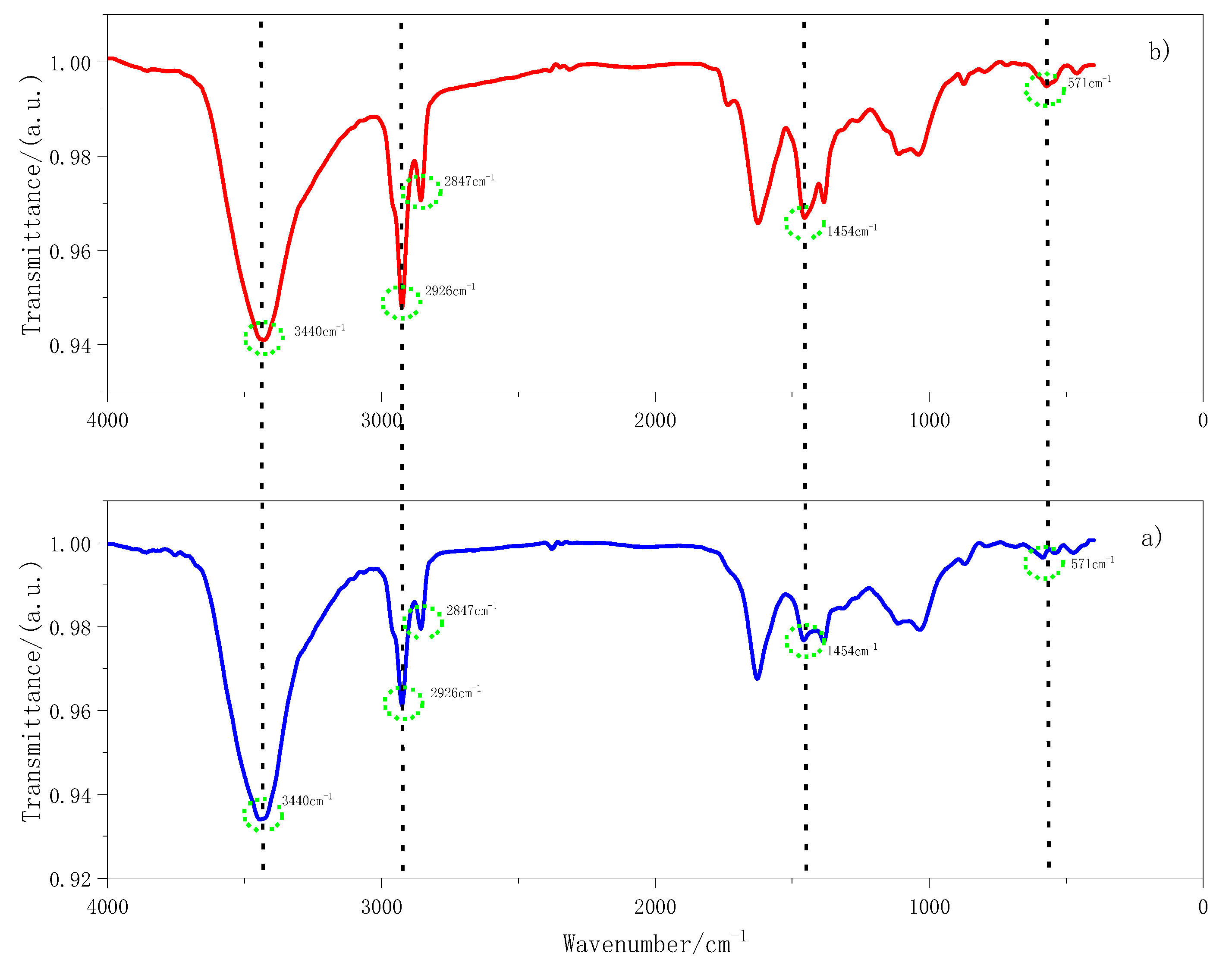
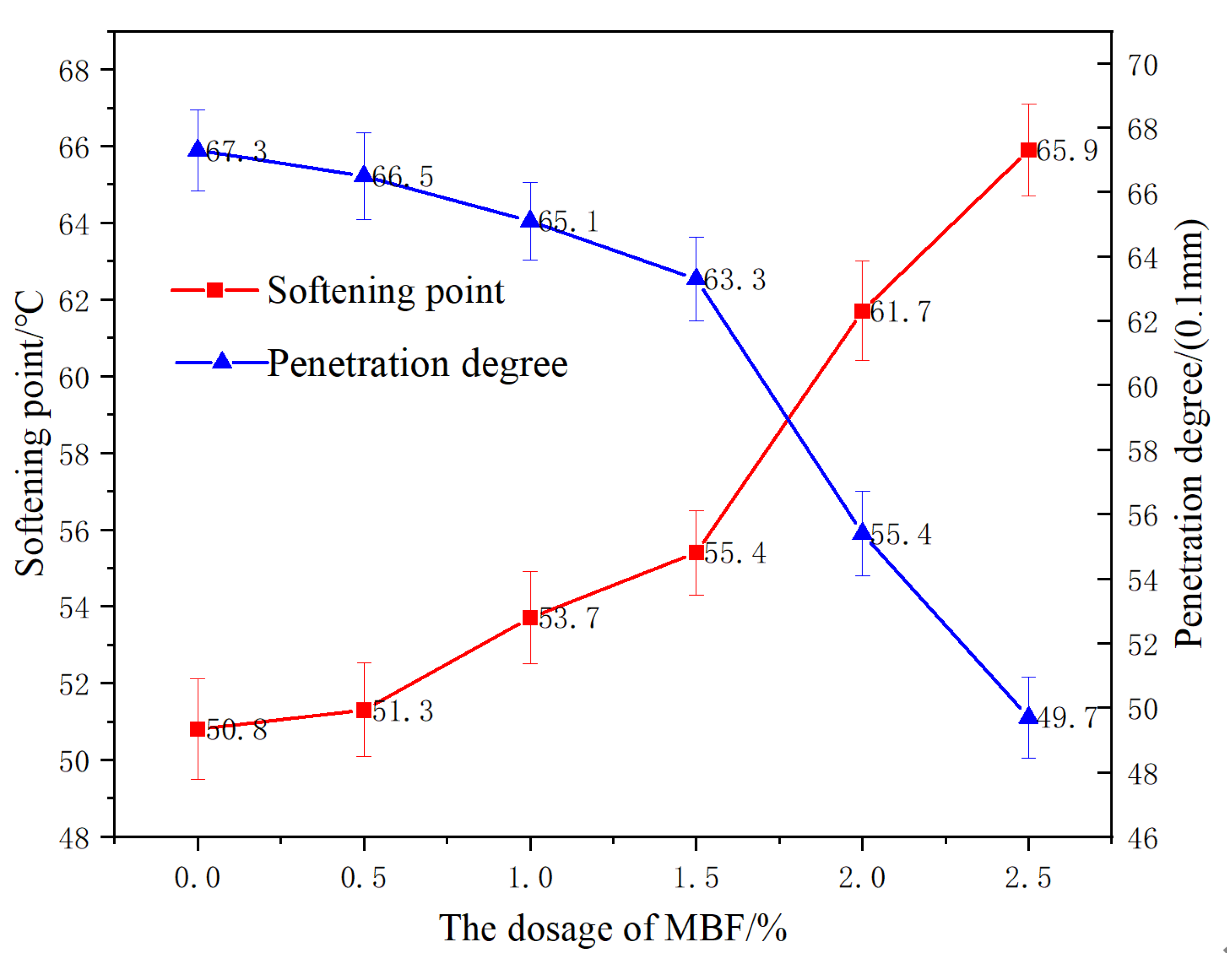
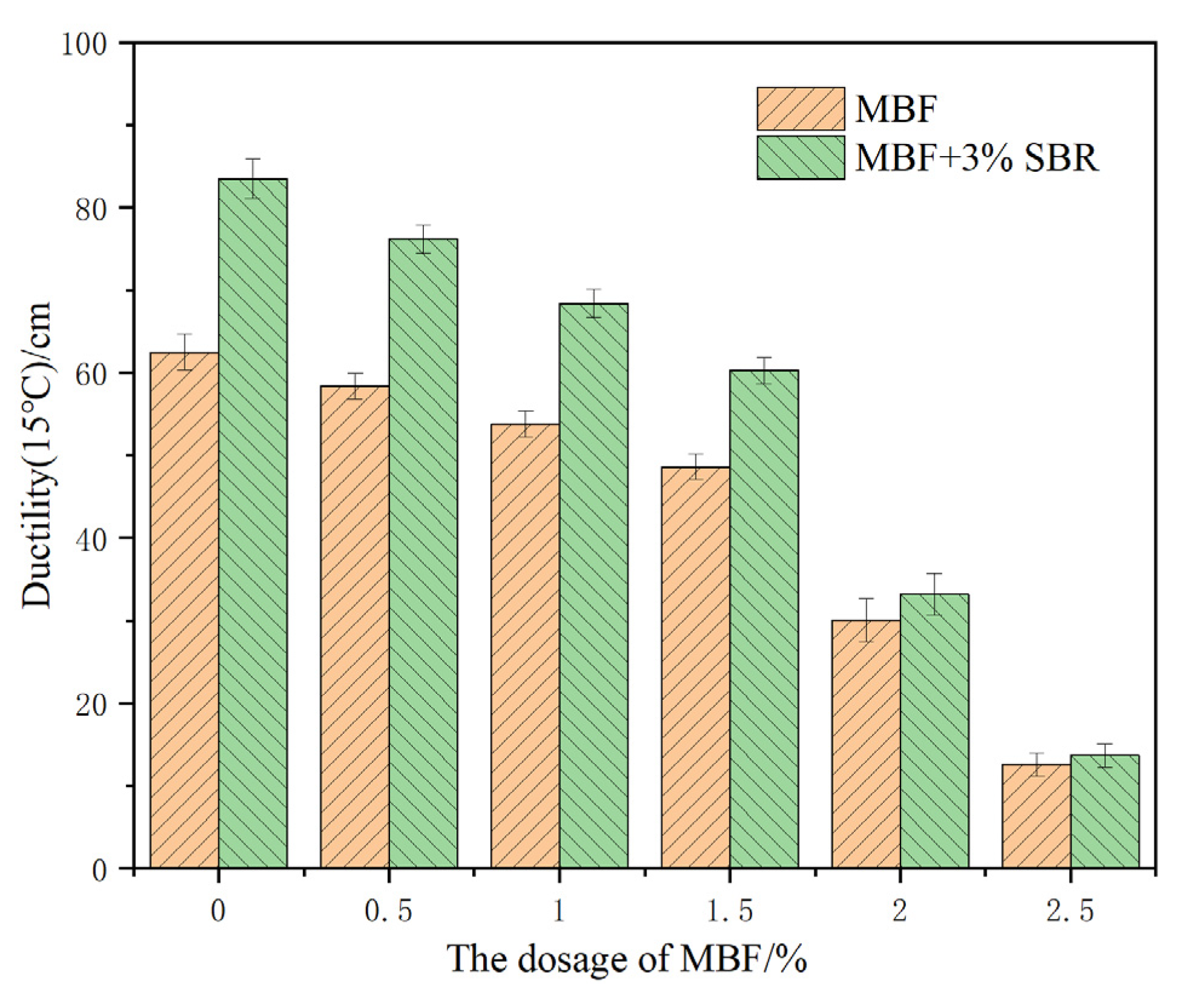
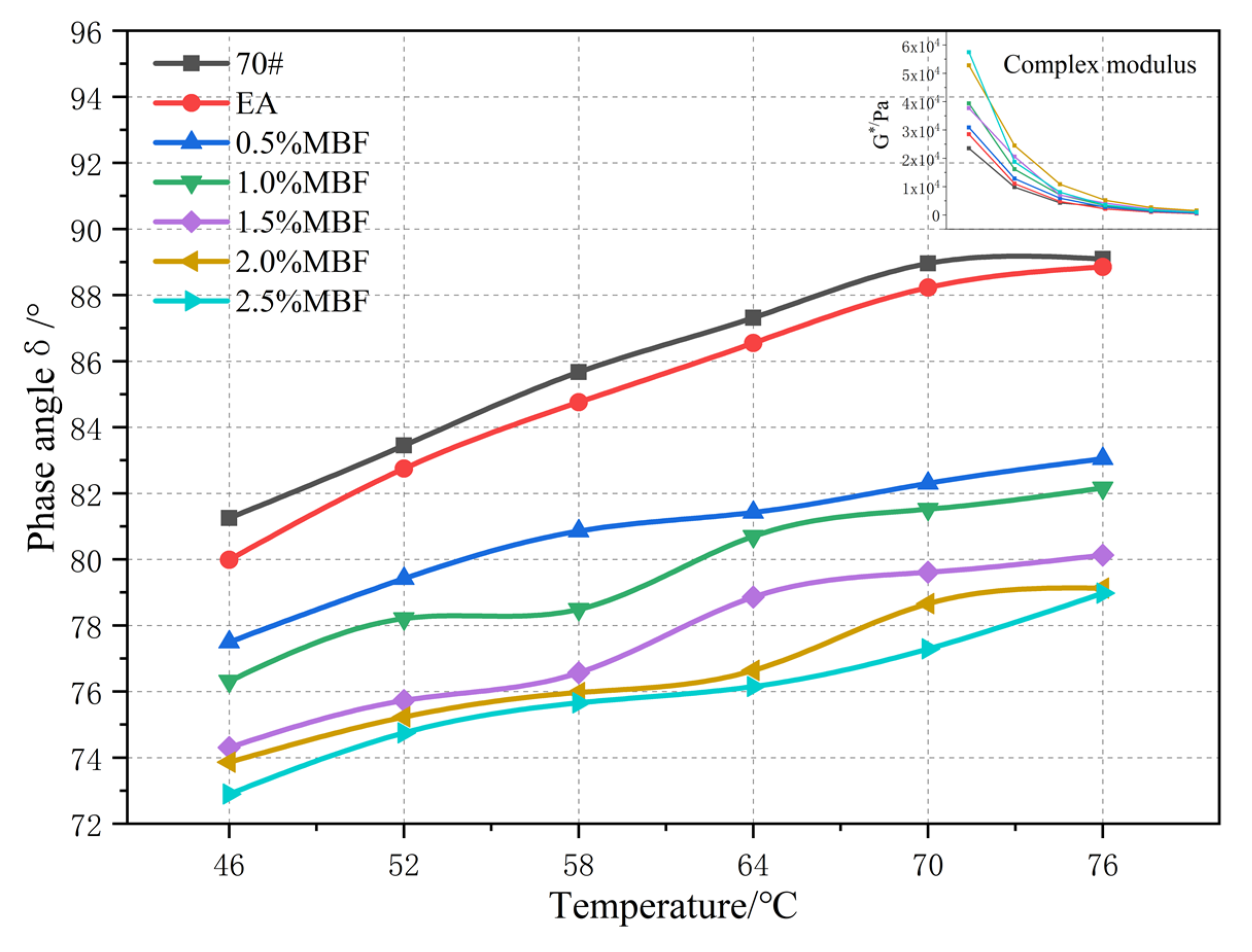

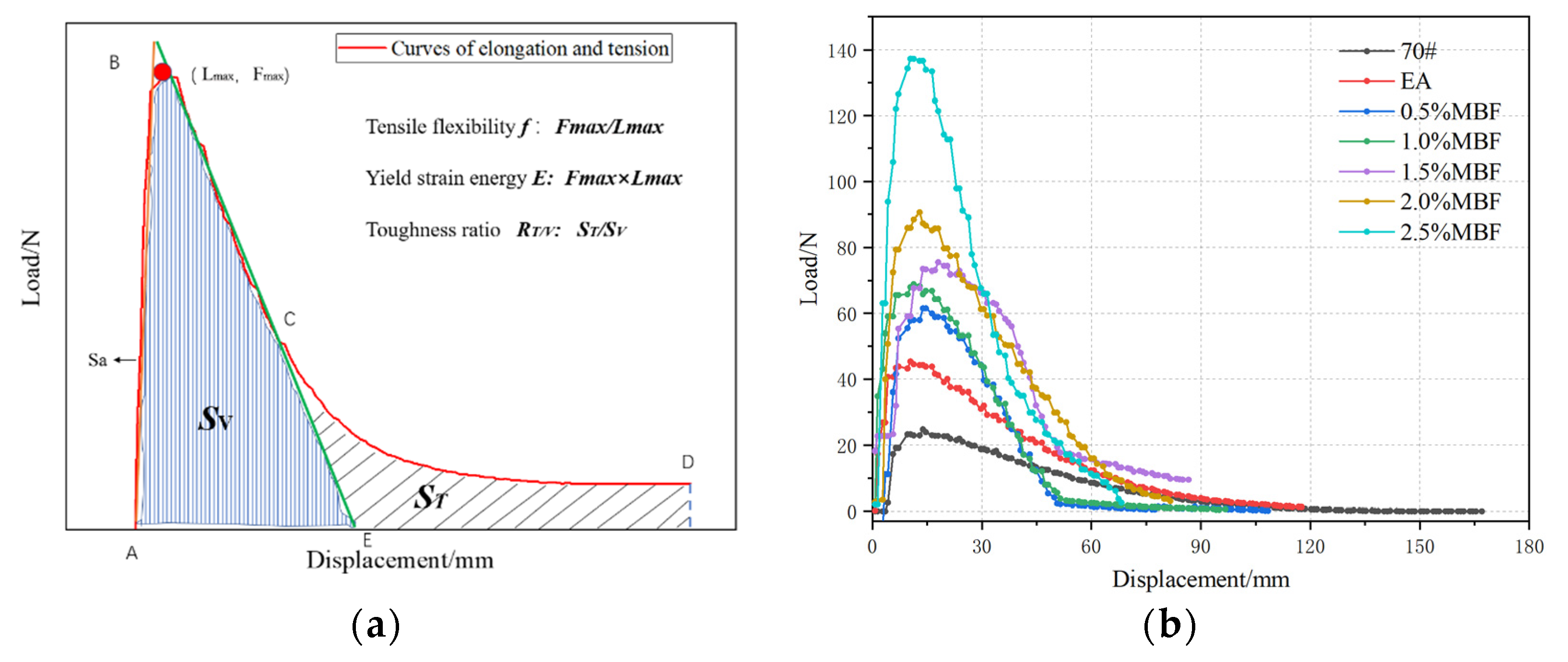
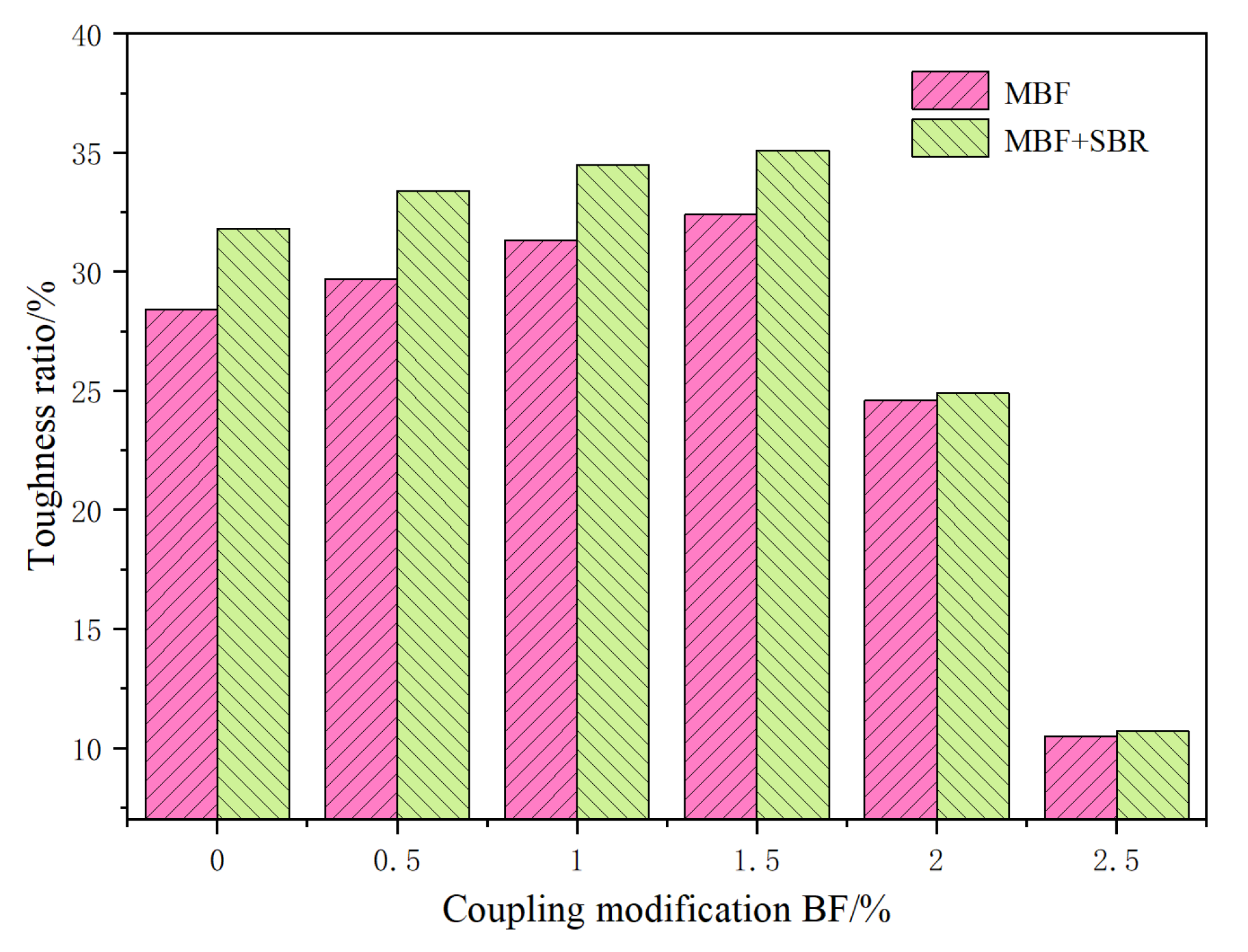

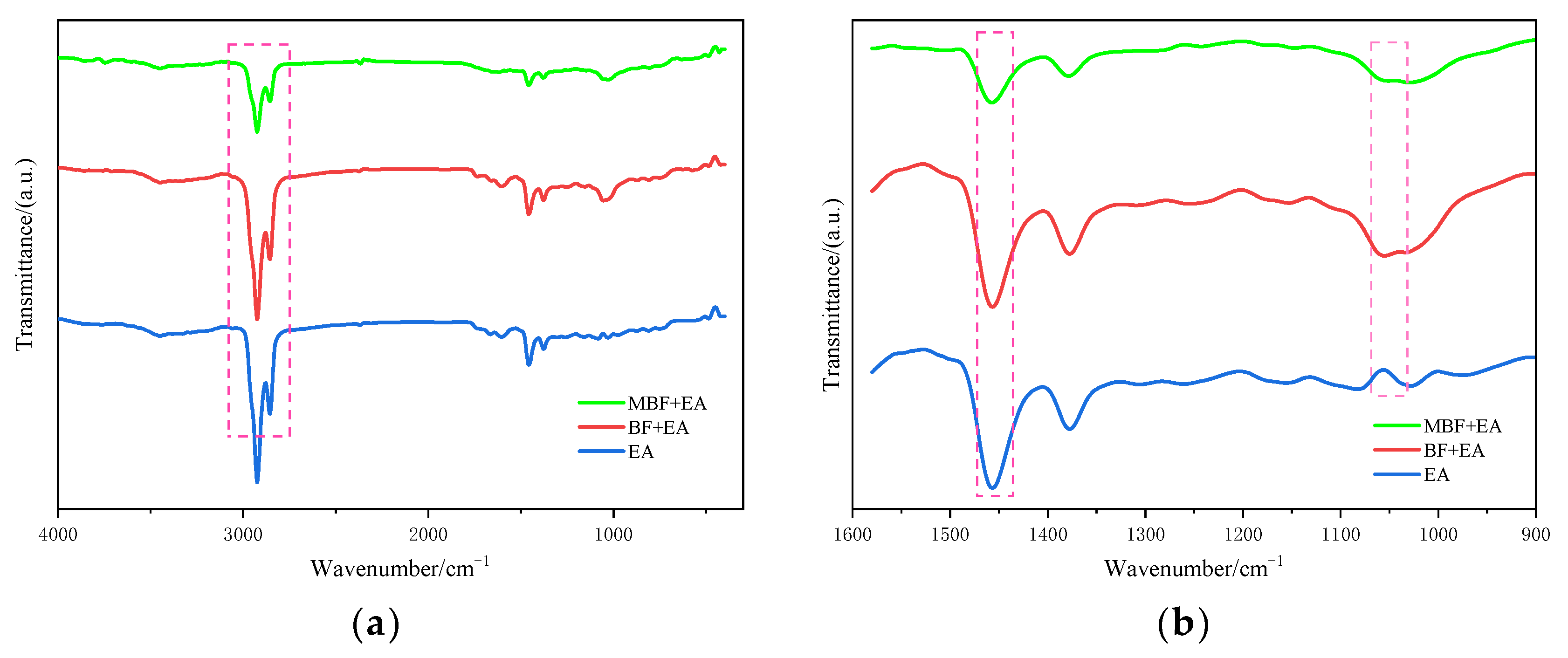
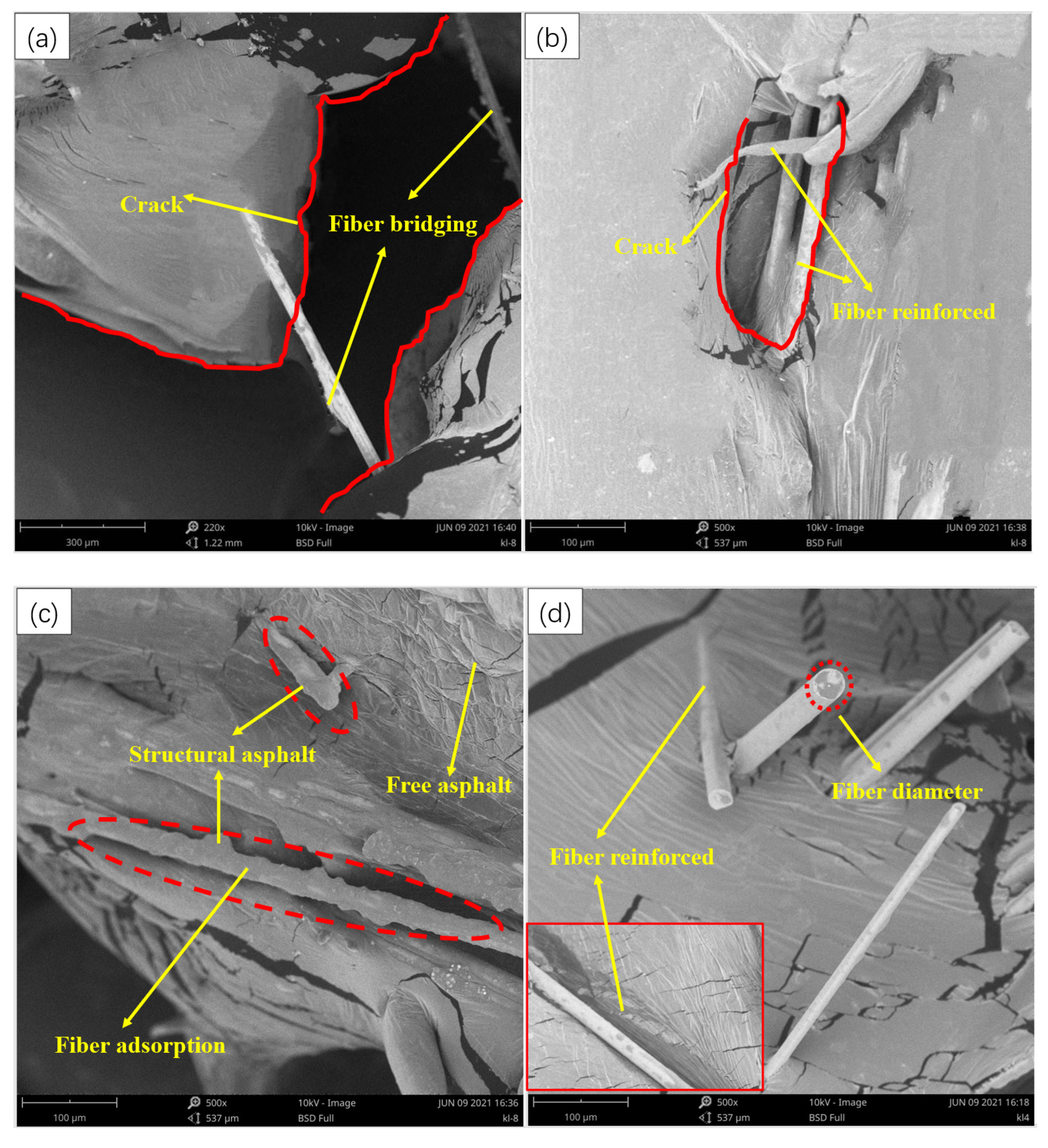
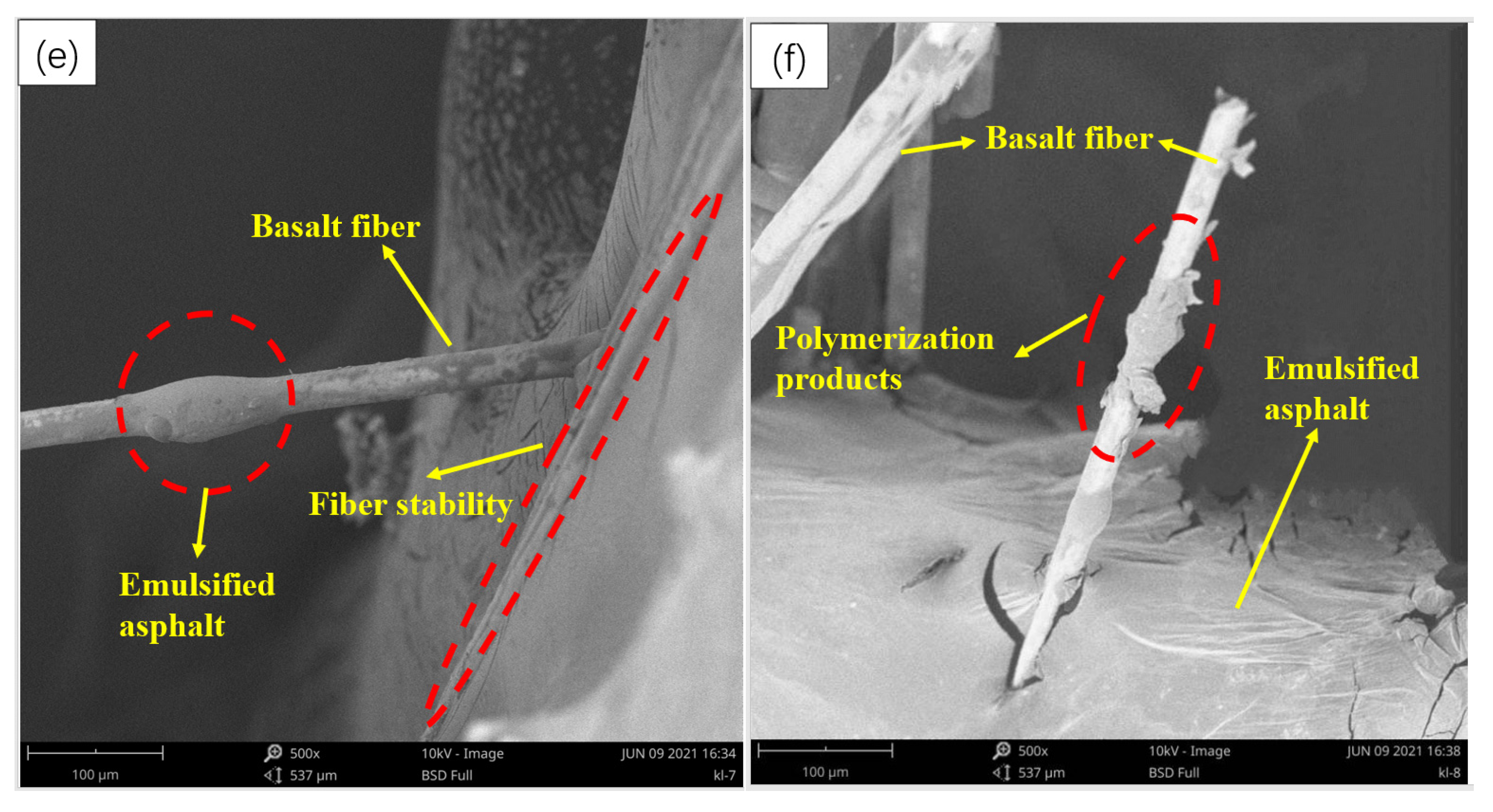
| Fundamental Index | Specification Limits | Test Results | |
|---|---|---|---|
| Particle charge | - | Cationic (+) | |
| Evaporation residue | Evaporation residue content (%) | ≥60 | 64.5 |
| Degree of postpone (15 °C)/cm | ≥40 | 62.5 | |
| Degree of needle (25 °C)/0.1 mm | 50–130 mm | 78.7 | |
| Soften point | - | 52 | |
| Storage stability | 1d (%) | ≤1 | 0.6 |
| 5d (%) | ≤5 | 2.4 | |
| Fundamental Index | Test Results |
|---|---|
| Appearance | Milky white liquid |
| Evaporation residue content/% | 50 ± 1 |
| Viscosity (mPa·s) | 1300–2000 |
| pH | 5–7 |
| Fundamental Index | Test Results |
|---|---|
| Equivalent diameter/μm | 13–16 |
| Fiber length (mm) | 10–12 |
| Relative density (g/cm3) | 2.4 ± 0.1 |
| Breaking strength (MPa) | 2800–3200 |
| Elastic modulus (GPa) | 80–90 |
| Breaking elongation (%) | 3.1 |
| Heat resistance | 170 ± 5 °C No change in surface |
| Fundamental Index | Test Results |
|---|---|
| Boiling point (°C) | 213 |
| Density (ρ20g/m) | 0.949 |
| Refractive index (ND25) | 1.429 |
| Flash point (°C) | 88 |
| Purity (%) | ≥99 |
| Element | O | C | Si | Al | Na | Fe | Mg | Ca | |
|---|---|---|---|---|---|---|---|---|---|
| Original BF | Weight percentage | 44.14 | 23.63 | 13.63 | 5.85 | 2.07 | 4.72 | 1.96 | 2.92 |
| Atomic percentage | 47.56 | 34.57 | 7.78 | 3.81 | 1.58 | 1.48 | 1.41 | 1.28 | |
| Modification BF | Weight percentage | 36.34 | 37.08 | 17.11 | 3.88 | 1.42 | 3.31 | 1.42 | 2.16 |
| Atomic percentage | 33.47 | 49.47 | 10.71 | 2.3 | 0.99 | 0.95 | 0.94 | 0.86 | |
| MBF | 0% | 0.5% | 1.0% | 1.5% | 2.0% | 2.5% | 1.5% + SBR | |
|---|---|---|---|---|---|---|---|---|
| −12 °C | S/MPa | 133 | 143 | 157 | 166 | 209 | 247 | 153 |
| m | 0.375 | 0.359 | 0.343 | 0.331 | 0.302 | 0.278 | 0.342 | |
| K | 354.66 | 398.32 | 457.72 | 501.51 | 692.05 | 888.48 | 418.12 | |
| −18 °C | S/MPa | 347 | 369 | 394 | 414 | 465 | 513 | 407 |
| m | 0.327 | 0.316 | 0.304 | 0.291 | 0.262 | 0.236 | 0.292 | |
| K | 1061.16 | 1167.72 | 1296.0 | 1422.68 | 1774.80 | 2173.72 | 1393.83 | |
Publisher’s Note: MDPI stays neutral with regard to jurisdictional claims in published maps and institutional affiliations. |
© 2021 by the authors. Licensee MDPI, Basel, Switzerland. This article is an open access article distributed under the terms and conditions of the Creative Commons Attribution (CC BY) license (https://creativecommons.org/licenses/by/4.0/).
Share and Cite
Lu, Z.; Kong, L.; He, Z.; Xu, H.; Yang, K.; Shen, Z.; Huang, Z. Modification Mechanism and Rheological Properties of Emulsified Asphalt Evaporative Residues Reinforced by Coupling-Modified Fiber. Materials 2021, 14, 7363. https://doi.org/10.3390/ma14237363
Lu Z, Kong L, He Z, Xu H, Yang K, Shen Z, Huang Z. Modification Mechanism and Rheological Properties of Emulsified Asphalt Evaporative Residues Reinforced by Coupling-Modified Fiber. Materials. 2021; 14(23):7363. https://doi.org/10.3390/ma14237363
Chicago/Turabian StyleLu, Zhaofeng, Lin Kong, Zhaoyi He, Hao Xu, Kang Yang, Zuzhen Shen, and Zhaodong Huang. 2021. "Modification Mechanism and Rheological Properties of Emulsified Asphalt Evaporative Residues Reinforced by Coupling-Modified Fiber" Materials 14, no. 23: 7363. https://doi.org/10.3390/ma14237363
APA StyleLu, Z., Kong, L., He, Z., Xu, H., Yang, K., Shen, Z., & Huang, Z. (2021). Modification Mechanism and Rheological Properties of Emulsified Asphalt Evaporative Residues Reinforced by Coupling-Modified Fiber. Materials, 14(23), 7363. https://doi.org/10.3390/ma14237363





